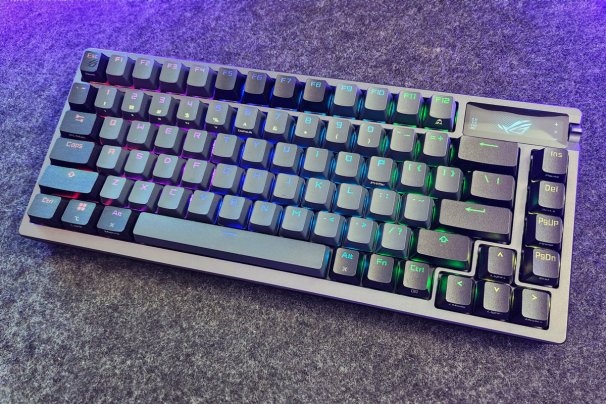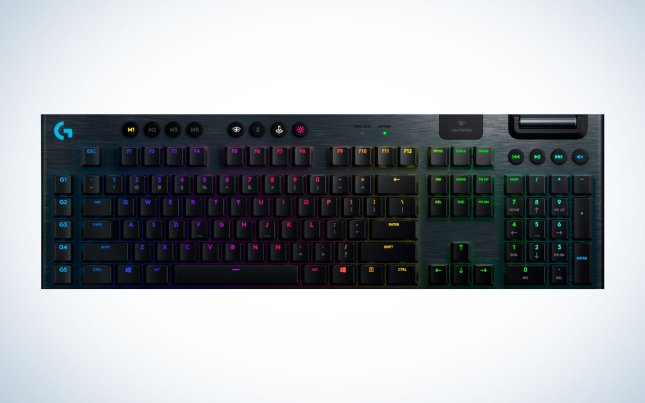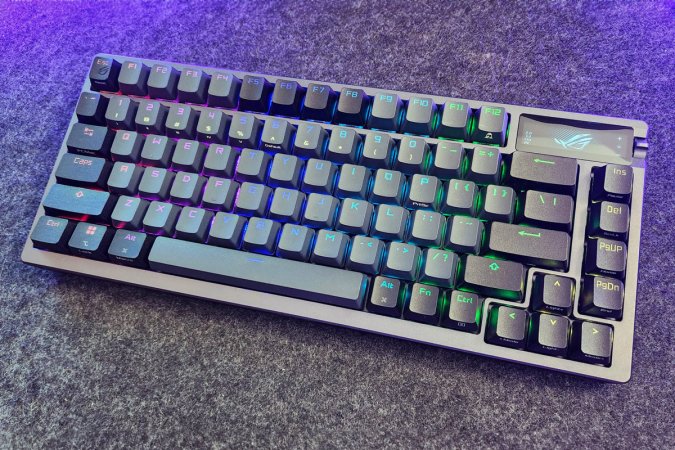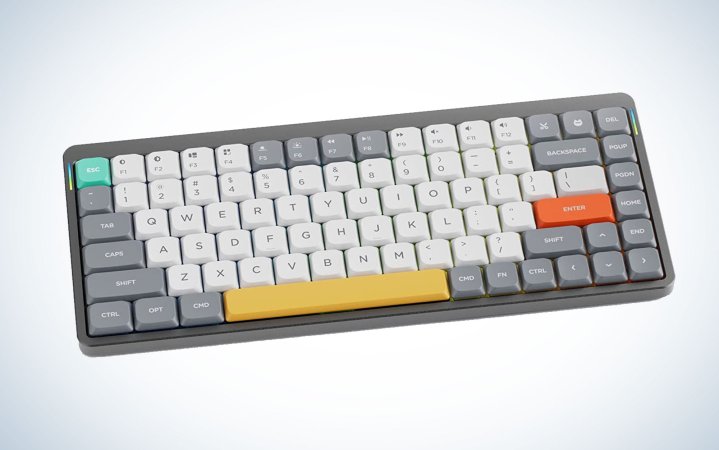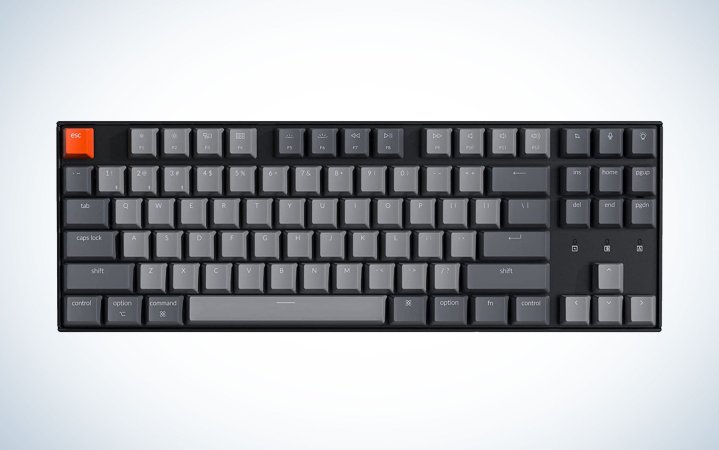We may earn revenue from the products available on this page and participate in affiliate programs. Learn more ›
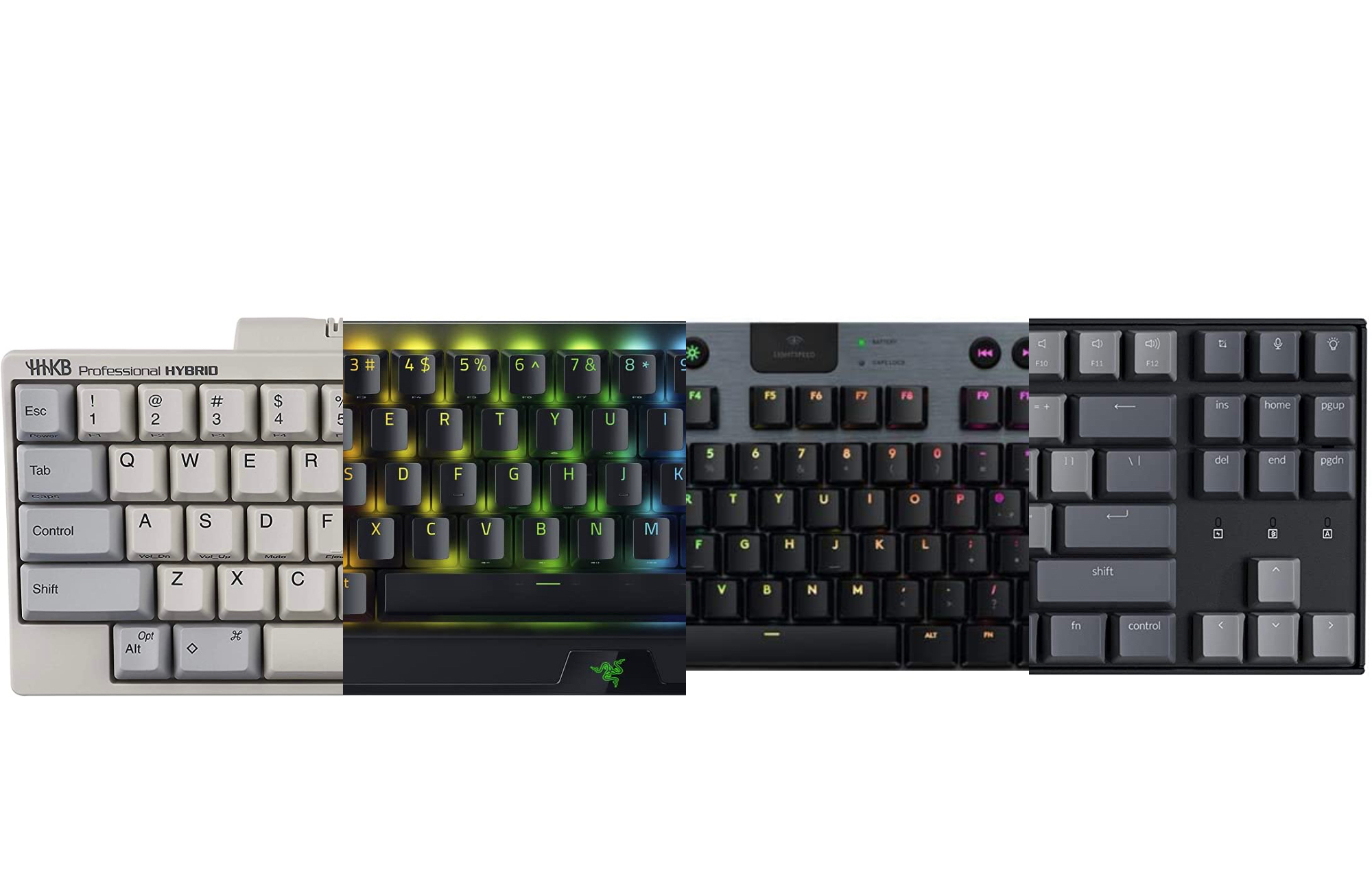
Mechanical keyboards have never been so popular and they’re finally ready to cut the cord. While wireless mechanical keyboards are nothing new, they’ve been a very rare commodity until recently. It’s only been over the last few years that the manufacturers behind the best mechanical keyboards have started to make wireless models. Once two different paths, the best wireless mechanical keyboards truly make you feel like you’re getting the best of both worlds: mechanical reliability and wireless convenience.
- Best overall: Logitech G915 Lightspeed
- Best for gaming: ASUS ROG Azoth
- Best for the office: Razer Pro Type Ultra
- Best for programmers: Happy Hacking Keyboard Hybrid Type-S
- Best compact: Nuphy Air75
- Best budget: Keychron K8
How we chose the best wireless mechanical keyboards
I’ve been a keyboard enthusiast since 2015, when I purchased the Logitech G710+ with Cherry MX Brown switches. Since then, I’ve reviewed dozens of mechanical keyboards for sites, including IGN, Tom’s Hardware, and MMORPG.com, spanning brands big and small. I’ve built more than a dozen custom keyboards and have a collection totaling more than $3,500 in total value. Even with that collection, I still find myself looking for new and exciting keyboards to buy and build.
Even though my collection spans widely, it’s only in the last few years that I’ve really begun to consider certain wireless keyboards among the best out there. The reason is simple: It’s only over those few years that wireless mechanical keyboards have gotten good enough to compete with the best keyboards available right now. But now that they have, there are wireless mechanical keyboard options to fit every user without the sacrifices of yesteryear.
To create this list, I researched the best wireless options from as many major brands as I could find. I dug deep into user reviews to weed out the “good on paper” options and left only those that would deliver the very best in reliability and performance. Finally, I relied on my own experience with a number of the boards and brands up for consideration. With the exception of only two keyboards, the Razer Pro Type Ultra and Keychron K8, I’ve spent dozens, if not hundreds, of hours with each keyboard on this list.
The best wireless mechanical keyboards: Reviews & Recommendations
Now that you have a sense of what to look for, we’ve put together a list of the best wireless mechanical keyboards you can buy right now. They come in different form factors to meet all kinds of needs, depending on whether you’re playing games, getting work done, or simply want the most pleasant typing experience. There are a lot of great keyboards out there, but these are all exceptional.
Best overall: Logitech G915 Lightspeed
All Dressed Up
Pros
- Exceptionally well-built
- Thin, low-profile design with well-isolated RGB
- User-friendly software for advanced functions
- Incredibly responsive
Cons
- Expensive
Why it made the cut: The Logitech G915 Lightspeed looks sharp, has a great typing feel, and comes with lots of special features.
Specs
- Layout: Full-size (TKL option available)
- Switches: Clicky, Linear, Tactile; Low-Profile
- Connection type: Bluetooth, 2.4GHz, Wired
- Battery life: 135 days (RGB off), 30 Hours (100% brightness)
- Software: Logitech G-Hub
The Logitech G915 Lightspeed has something for everyone. It’s a full-size keyboard (with a tenkeyless version available) that’s ready-made for gaming but is great for work, too. It features low-profile switches, which are shorter and flatter than a normal keyboard, and a thin 22mm design, making it an easy transition for laptop and Magic Keyboard users. It also features Logitech’s LIGHTSPEED wireless technology, providing it with gaming-grade responsiveness. Logitech’s G Hub software also allows you to easily map Windows shortcuts, making navigating your PC faster and easier than competing keyboards. Add to that dedicated media controls, excellent switches, programmable (and optional) RGB lighting, and you have a keyboard that’s a powerhouse for both work and play.
All of this functionality comes at a steep price of $249. The TKL version is significantly cheaper at $189 but drops the number pad, which may be a dealbreaker for some. Logitech also limits key remapping to just the G-keys, but with three onboard profiles, that tallies up to 15 programmable buttons, which will be plenty for most users. If you can afford it, this is the Logitech mechanical keyboard to buy.
Best for gaming: ASUS ROG Azoth
Best for gaming
ASUS ROG Azoth
Pros
- Tri-mode, high-speed wireless connectivity
- Smooth switches that feel, sound, and perform great
- Tremendous battery life
Cons
- Battery life drops substantially with RGB-enabled
Why it made the cut: The ROG Azoth offers the best sound and feel of any gaming keyboard, excellent programmability, and shockingly great battery life.
Specs
- Layout: Compact TKL
- Dimensions: 12.8 x 5.4 x 1.6 inches
- Switches: Linear, Clicky, Tactile
- Keycaps: Doubleshot PBT
- Backlight: Yes, programmable RGB
- Software: ASUS Armoury Crate
The ASUS ROG Azoth is easily the best mechanical gaming keyboard on the market today. It’s built to an incredible standard, complete with some of the smoothest and best-sounding switches we’ve ever tested in a gaming keyboard. Its compact layout is perfect for a gaming PC battlestation, providing your mouse with the additional space you need for first-person shooters. But thanks to its exceptional programmability, you have access to all of the functions of a larger tenkeyless keyboard, as well as advanced features like macros, media controls, and Windows shortcuts. Despite its smaller size, it has considerable heft thanks to layers of foam and silicone throughout its construction to quiet your keystrokes and improve its acoustics. There’s even an OLED screen and adjustable volume knob that allow you to customize its settings and display custom animations.
The Azoth features tri-mode wireless connectivity, as well as a traditional USB Type-C to Type-A wired connection with its detachable cable. Over Bluetooth, you can connect up to three devices, which is perfect for when you need to get work done. For gaming, it supports ASUS’s SpeedNova Wireless technology, which offers wired-like one-millisecond connection speeds. It’s also incredibly power efficient, supporting up to 2,000 hours of playtime with the lighting turned off.
The keyboard is a looker with its per-key RGB backlighting, but like most backlit keyboards, running the backlight at full brightness significantly reduces battery life. ASUS doesn’t provide a rating with backlighting on, but in our testing, it seems like full brightness drops that to roughly 100 to 200 hours. It’s a big drop, but still fairly generous and well worth the other benefits it has to offer.
If you’re looking for a cheaper alternative to the ASUS ROG Azoth, the Razer BlackWidow V3 Mini HyperSpeed wireless gaming keyboard is a great choice. That’s in part thanks to its compact design and wired-like performance. With the company’s proprietary HyperSpeed wireless technology, it’s able to maintain a reliable 1ms connection that’s free of interference-based stutters. It also features bright RGB backlighting, complete programmability, and excellent doubleshot ABS keycaps.
Razer’s only 65-percent keyboard, the BlackWidow V3 Mini Hyperspeed, keeps things compact. It leaves dedicated media keys on the cutting room floor, so if you need an actual volume wheel, you’re best looking elsewhere. And while the battery life is great at 200 hours with RGB turned off, that plummets to 48 hours at 30 percent and 17 hours with backlighting turned all the way up. Thankfully, it can recharge to 50 percent in just 30 minutes and to 100 percent in five hours, so you won’t need to stay plugged in for long when you do run it dry.
Best for the office: Razer Pro Type Ultra
Razer Performance in a Professional Package
Pros
- Clean, minimalist look
- Simple white backlighting
- Silent switches
- Bluetooth and 2.4GHz connection options
Cons
- Simple ABS keycaps that will shine sooner than later
- Advanced features require Synapse software
- One switch type
- Low battery life on max brightness
Why it made the cut: Razer is known for its gaming keyboards, but the Pro Type Ultra is a more “grown-up” take with plentiful, office-friendly features.
Specs
- Layout: Full-size
- Switches: Razer Yellow (Linear, Silent)
- Connection type: Bluetooth, 2.4GHz
- Battery life: 214 hours (2.4GHz), 207 hours (Bluetooth), 13 hours (100% brightness)
- Software: Razer Synapse
Razer is best known for its flamboyant RGB gaming keyboards, but the Pro Type Ultra is altogether more grown-up. It features a clean, minimalist look with a silver deck, white keycaps, and simple white backlight. It also includes a plush gray wrist rest to support your arms and maintain your typing form.
The Pro Type Ultra sports many of the features found in elite productivity keyboards, including both Bluetooth and 2.4GHz wireless support. If you pair the keyboard with its mouse mate, Razer Pro Click Mini wireless mouse, you can use the 2.4GHz USB receiver to connect to both devices, saving you a second port.
There is one downside for mechanical switch aficionados. The Pro Type Ultra is only available with silent linear switches, which makes sense if you’re trying to be a courteous office worker, but might cramp some enthusiasts’ style. It’s a keyboard built for a very specific job and setting, though, and it excels in that situation.
Best for programmers: Happy Hacking Keyboard Hybrid Type-S
A Modern Classic
Pros
- Layout designed for programmers
- Compact design is great for traveling.
- Topre switches are especially comfortable (and quiet!)
Cons
- Alternative layout creates learning curve
- Extremely expensive
Why it made the cut: This retro mechanical keyboard is a modern classic; it’s been a mainstay in the programming world for years and doesn’t seem to be leaving anytime soon.
Specs
- Layout: 60-percent
- Switches: Electro-capacitive
- Connection type: Bluetooth, Wired
- Battery Life: 3 months
- Software: None
The Japanese Happy Hacking Keyboard is iconic in the mechanical keyboard world and a longtime favorite among computer programmers. Its layout is centered on efficiency as it applies to coding. The key arrangement shifts the Control key to the Caps Lock position and Delete to Backspace. These streamline the programming process by allowing for less hand movement, allowing you to input commands more quickly and get more work done with less backtracking. The tiny 60-percent layout reserves less common inputs for secondary commands and makes it more portable to easily continue work at home.
At the same time, the HHKB uses electro-capacitive Topre key switches that feel lightweight, tactile, and quiet, while still offering a crisp typing experience that won’t irritate your fellow programmers. These switches are excellent for typing over long hours and reduce finger fatigue due to their lightweight tactility.
The biggest downside to Happy Hacking keyboards, including the Hybrid Type-S, is the price. Because electro-capacitive switches are expensive to produce and not widely available in the United States, they’re typically very expensive. Bluetooth-enabled models begin at $277 on Amazon for the Classic design, all the way up to $385 for the silenced Type-S model. Also, as a compact keyboard with an alternative layout, there is a steeper learning curve than usual when you use it for the first time, so expect to type slowly and imprecisely for the first few weeks. Still, after trying dozens of keyboards, there is nothing quite like it.
Best compact: Nuphy Air75
Get Low
Pros
- Designed for use with Mac (also works with PC)
- Can replace the keyboard on MacBook Pro
- Thin and easy to travel with
- Hot-swappable switches with plenty of travel
Cons
- Standard-height switches are not supported
- Can’t sit atop all laptop keyboards
Why it made the cut: The Nuphy Air75’s Mac-friendly design is exceptionally portable and feels great to use with its Gateron Low Profile switches.
Specs
- Layout: Compact TKL (75-percent)
- Switches: Gateron Low Profile Red, Brown, or Blue
- Connection type: Bluetooth, 2.4GHz, Wired
- Battery life: Up to 48 hours
- Software: Nuphy Console
The Nuphy Air75 is the mechanical keyboard Mac users have been waiting for. With Apple-centric keycaps that match the function row of the modern MacBook, the Nuphy Air75 is actually designed to sit on top of your existing MacBook keyboard and become a true mechanical replacement. It’s only 16mm high, so it doesn’t drastically alter the keyboard’s profile if you actually stack it on top. (To be clear, you do not have to do that.)
That doesn’t mean Windows users are left out in the cold. With a recent firmware update, you can easily swap between a standard function row and MacBook functions. Nuphy also includes alternate Windows keycaps in the box.
Regardless of your platform, the Nuphy Air75 is a great wireless mechanical keyboard. It features Gateron low-profile switches, hot-swap sockets to easily change switches, per-key RGB backlighting, and your choice of Bluetooth 5.0 or 2.4GHz for high-speed gaming. It’s also one of the few low-profile wireless keyboards to feature PBT keycaps for added longevity and an improved typing experience.
Best budget: Keychron K8
Great Performance, Great Value
Pros
- Affordable
- Customizable lighting, switch, and frame upgrades
- Hot-swappable switches
Cons
- Cheap ABS keycaps
- White-only backlighting
Why it made the cut: Keychron has become one of the biggest names in budget mechanical keyboards, and the K8 is a good example of why: plentiful features and performance at an even better price.
Specs
- Layout: TKL
- Switches: Gateron G Pro or Gateron Optical in Red, Blue, or Brown
- Connection type: Bluetooth, Wired
- Battery life: 3 months
- Software: None
The Keychron K8 is a banger of a budget keyboard. It offers many of the bells and whistles of high-end keyboards at a fraction of the cost. For only $69.99, you’ll get pre-lubed Gateron Pro mechanical switches, hot-swappable switch sockets to try new ones (and replace switches that may get broken in the future), reliable Bluetooth 5.1, and per-key backlighting for typing in the dark. The K8 also features native Mac support so you can easily swap use it on a Windows PC or Apple Mac.
The lower price comes at the expense of per-key RGB and some pretty generic keycaps. That said, Keychron offers the ability to spend a little extra and upgrade the keyboard with RGB backlighting and an aluminum frame. If you’re a gamer, you can also swap to optical switches for faster actuation. Some of its shortcomings, like a total lack of configuration software, cannot be overcome: Still, it’s a high-quality option for less than you’d normally expect to spend on mechanical keys.
Things to consider before buying a wireless mechanical keyboard
The wireless mechanical keyboard has a somewhat checkered history. For a time, wireless connectivity and mechanical switches felt like opposite technical upgrades. Mechanical keys, which use a physical switch to “actuate” your inputs, were prized for their superior typing feel and the reliability of a physical switch. Wireless keyboards offered convenience, but often at the expense of technical performance, thanks to additional input lag and small potential for missed inputs.
That hasn’t been the case for a few years now, though. Wireless keyboards, particularly those with Wi-Fi connection, offer reliable connections with virtually no lag. Battery life has improved. Suddenly, the two feel like a natural pair. You can get convenience and performance, together, in a single device.
When shopping for a wireless mechanical keyboard, the most important thing to consider is how you’ll actually be using it. Do you need the fastest connection or just something reliable that won’t miss a keystroke? Battery life, charging, and form factor are also important, especially if you’re planning on taking it to and from work every day. Lastly, it’s important to choose a switch that matches your taste and needs. Here are the big four things to consider when buying a wireless mechanical keyboard.
Form factor
Keyboards come in all shapes and sizes. Keyboard makers will change up a keyboard’s size, number of keys, and, occasionally, its layout to optimize it for different use cases and preferences. Here are the most common layouts and how they’re typically used:
- Full-size: Technically, a traditional full-size keyboard with a full number pad and function row has 104 keys. Manufacturers refer to any keyboard with a numpad and function keys as a full-size, including models with even more than that. Full-size keyboards are often preferred for productivity tasks due to the embedded Numpad.
- Tenkeyless: Tenkeyless, or TKL, keyboards are identical to full-size keyboards, save for the fact that they do not include a number pad. They traditionally feature 87 keys, but that number can vary either way depending on any unique twists the manufacturer might include. They are a good middle-ground between performance and compactness. A compact TKL is sometimes called a 75-percent and removes some of the lesser-used keys (like Pause and Scroll Lock) for an even more compact layout.
- 65-percent: 65-percent keyboards strip away a few more keys from the TKL layout, cutting the keyboard down to 65 to 68 keys. They do away with the function row and limit the navigation and editing cluster to a single column of 3 to 4 keys on the right side. The essential keys that have been removed are still accessible, though, as secondary commands accessed with key combinations. These keyboards are often viewed as a good compact option for users who don’t typically use the missing keys but may still need navigation and editing buttons or arrows for gaming.
- 60-percent: 60-percent keyboards are the most compact of all and feature only 60 keys. This tiny form factor does away with the function row, arrow keys, and all navigation and editing buttons and instead makes most accessible as secondary commands (this varies between keyboards). These keyboards are often enjoyed by gamers and keyboard enthusiasts who mainly type or use WASD keys in games.
Wireless mechanical keyboards can come in all of these form factors. If you’re planning on leaving the keyboard in one place and have space to spare, a full-size keyboard is a safe bet. But if you plan to travel, that same keyboard will feel bulky and hard to conceal in a bag. For portable use, compact TKLs and 65-percent keyboards can be excellent options.
Connection types
Many wireless keyboards support Bluetooth as their primary connection type. For normal work tasks and web browsing, this is typically fine, though it’s always smart to read user reviews to be sure. Avoid keyboards that use any Bluetooth version below 4.0 and, ideally, look for 5.0 or higher. An older Bluetooth version indicates the keyboard itself is older and perhaps from a time when reliability issues were more prevalent. Worse, it could indicate that the manufacturer isn’t willing to invest in the added performance and battery life newer Bluetooth versions have brought, which doesn’t bode well for the rest of the product.
For gaming, Bluetooth isn’t a good choice. The increased delay between pressing a key and seeing your action pop up on-screen can be problematic for competitive games (less so for casual games) and leave you at a disadvantage. Instead, look for wireless mechanical keyboards that offer a 2.4GHz wireless connection via a USB dongle. While it requires a USB slot, the more “direct” wireless connection cuts down input latency dramatically. Once a non-starter for gamers, most wireless gaming keyboards are now indistinguishable from their wired counterparts
Key switches
One of the most important characteristics of any mechanical keyboard is the type of switch it uses. Unlike a membrane keyboard that uses a rubber mat under the entire keyset, mechanical keyboards use a physical switch under every key. These switches can be linear, clicky, and tactile.
Linear switches are smooth from the top of the press to the bottom and are usually colored red. They don’t offer any kind of feedback to let you know when an input has been sent. They’re great for gaming when you need to send multiple presses quickly but can result in more typos as you learn to use them.
Clicky switches are often enjoyed by typists and are usually colored blue. They offer a physical bump as well as an audible click when a letter is sent. Though they can be satisfying to use, the added noise can disturb coworkers or roommates.
Tactile switches are a middle ground between clicky and linear switches. They feature a small bump that can be felt in your fingers halfway through the press but don’t have an audible click. They are usually lightweight enough to be used for gaming and aren’t as distracting to people who may be working nearby.
Battery life and charging
The final thing to consider with any wireless mechanical keyboard is its rated battery life and how it accepts a charge. Newer keyboards can offer outstanding battery life, even extending multiple years (for example, the Logitech Pop Keys). That’s not a given, however, as the size of the battery, connection type, and backlighting all impact how long the keyboard will last between recharges.
This is especially important for keyboards with RGB backlighting. These LEDs, while pretty, can dramatically reduce battery life. The Razer Blackwidow V3 Mini Hyperspeed, for example, is rated for 200 hours of use with the backlight turned off. With the RGB set to its full brightness, that drops all the way to 17 hours. It’s common for RGB to halve battery life, so bear that in mind when choosing the best keyboard for you.
For charging, most wireless keyboards today integrate nonreplaceable rechargeable batteries, though some less expensive models will rely on replaceable AA or AAAs. Though some keyboards offer tremendous battery life off a Duracell or two, we generally prefer rechargeable peripherals. They tend to produce less e-waste over the lifespan of your keyboard. (Would I prefer that companies make internal batteries replaceable? Of course, but that’s another conversation.) On a practical level, disposable batteries also open up the possibility that your device will stop working at a crucial time if you don’t have replacements handy.
FAQs
Gamers, like most PC users, tend to rely on full-size or TKL keyboards, since the number pad isn’t used in most games. In recent years, extra-compact 60- and 65-percent keyboards have become more popular among competitive players and streamers. Since most esports don’t utilize the function brown, number pad, or navigation and editing keys, removing them from the layout leaves more space for the sweeping mouse movements popular in competitive first-person shooters. The reduced size also allows for more ergonomic arm positioning for long hours at the computer. The smaller size does reduce their utility for productivity, however, so average gamers still tend to use more standard layouts.
Generally speaking, I prefer mechanical keyboards over models with membrane switches for their durability and superior typing feel. Mechanical keyboards offer independent switches under every key and are typically rated from 50- to 100-million key presses each. They also rarely change much over time, so the keyboard will feel just as good in five years as it does today with proper care. Critically, some mechanical keyboards allow you to swap in new switches, extending their lives and allowing you to upgrade them to fit your taste. These qualities combine to create a typing experience that many users find more satisfying, myself included.
That said, mechanical keyboards do have drawbacks. While prices have gone down, mechanical keyboards tend to be more expensive than membrane keyboards. Mechanical keyboards are also usually much louder than membrane keyboards, even when equipped with noise-reducing switches. Clicky switches, in particular, can be bothersome to roommates or coworkers.
Choosing the best wireless mechanical keyboard for you should be based on how you’ll be using it. If you’re used to typing on a laptop keyboard, it may be wise to choose one with low-profile switches that feel like a laptop’s. If you plan to travel with your keyboard, selecting a compact model that’s small and light enough to easily carry with you is a good choice. If you’re gaming, be sure to choose a keyboard that uses 2.4GHz instead of Bluetooth for wired-like responsiveness.
With those unique considerations in mind, there are also two factors that carry through to all wireless mechanical keyboards: battery life and switch type. No matter what you choose, be sure to keep its rated battery life in mind and whether or not any backlighting impacts it. Finally, choose a switch that’s a match for you. Clicky blue switches may be great for typing but can irritate coworkers with their added noise. Linear red switches are great for gaming but often lead to more typos while you’re learning to use the keyboard. Tactile brown switches have a bump when they actuate but no click and are also lightweight enough for gaming, making them a great choice as a first switch.
This depends on your needs, but you shouldn’t have to spend more than $100 to get a great wireless mechanical keyboard.
Final thoughts on the best wireless mechanical keyboards
- Best overall: Logitech G915 Lightspeed
- Best for gaming: ASUS ROG Azoth
- Best for the office: Razer Pro Type Ultra
- Best for programmers: Happy Hacking Keyboard Hybrid Type-S
- Best compact: Nuphy Air75
- Best budget: Keychron K8
The days of wireless mechanical keyboards playing second fiddle to their wired counterparts are behind us. Thanks to improved Bluetooth codecs and 2.4GHz wireless, maintaining a reliable connection isn’t the same problem it used to be. Likewise, improved lithium batteries and extended battery life help ward off the surprise disconnections that drove so many of us to stick with wired keyboards in the first place. It’s a new era for wireless mechanical keyboards, and they’re only going to get better from here.
